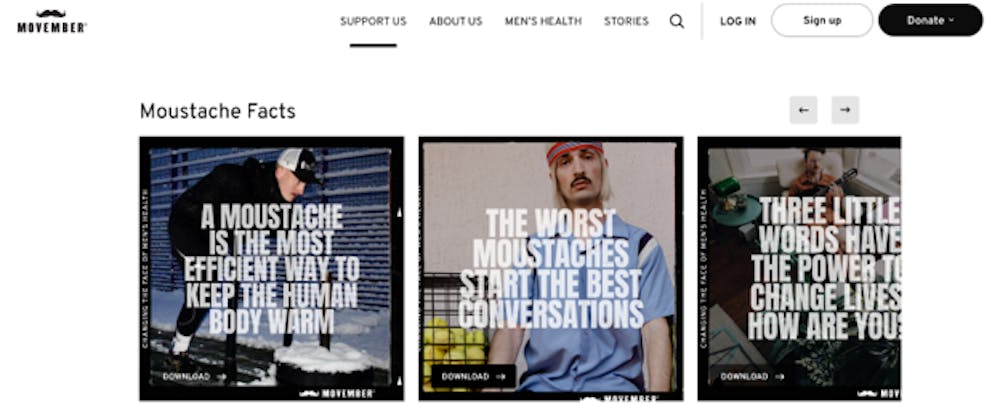The Future of Fundraising: Optimizing Impact with Large Language Models
It’s not news that peer-to-peer fundraising is a huge opportunity for charities. We’re more likely to respond (and be more generous) when a friend asks us to donate as opposed to a random stranger. Plus, peer endorsements promote trust in a complex system of requests for our money and attention.
It’s also not news that asking friends, family, and acquaintances to donate is hard. While charities try to reduce the burden on fundraisers by providing copy-paste templates, these don’t necessarily promote effective fundraising.

A selection of Movember’s fundraising resources for fundraisers’ social media campaigns
The trade-off here is that making fundraising easy is important to recruit fundraisers, but making fundraising look hard is important for actually raising the funds. Not only are we more willing to donate to someone that we see doing something difficult1 (think ALS’s viral ice bucket challenge), but we are also more likely to donate to someone that we see making a sustained effort with their fundraising such as regular and thoughtful posts.2
Thus, we face the age-old dilemma of harnessing the power of peer-to-peer fundraising: how can we make fundraising easy while making it look hard? The good news is, we do have a new tool available. Enter: Large Language Models (LLMs). Trained on immense pools of text data, these models understand, analyze, and generate human-like text and are the magic behind widely used artificial intelligence applications like ChatGPT.
Building off of what historically works for peer-to-peer fundraising, today we’ll break down the ways in which LLMs are an indispensable tool for charities seeking to tap into their golden network.
References
- Olivola, C. Y., & Shafir, E. (2018). Blood, sweat, and cheers: The martyrdom effect increases willingness to sponsor others’ painful and effortful prosocial acts. Available at SSRN 3101447. Retrieved from: https://papers.ssrn.com/sol3/papers.cfm?abstract_id=3101447
- Chapman, C. M., Masser, B. M., & Louis, W. R. (2018). The Champion Effect in Peer-to-Peer Giving: Successful Campaigns Highlight Fundraisers More Than Causes. Nonprofit and Voluntary Sector Quarterly, 089976401880519. doi:10.1177/0899764018805196 Retrieved from: https://journals.sagepub.com/doi/abs/10.1177/0899764018805196
- Flynn, F. J., & Lake, V. K. (2008). If you need help, just ask: Underestimating compliance with direct requests for help. Journal of personality and social psychology, 95(1), 128. (2008). If you need help, just ask: Underestimating compliance with direct requests for help. Journal of personality and social psychology, 95(1), 128. Retrieved from: https://pubmed.ncbi.nlm.nih.gov/18605856/
- Silver, I., & Small, D. A. (2023). Put your mouth where your money is: A field experiment encouraging donors to share about charity. Marketing Science. Retrieved from: https://www.researchgate.net/publication/373001447_Put_Your_Mouth_Where_Your_Money_Is_A_Field_Experiment_Encouraging_Donors_to_Share_About_Charity
- Tan, J., Yan, L., & Pedraza-Martinez, A. (2020). How to share prosocial behavior without being considered a braggart? In Proceedings of the 53rd Hawaii International Conference on System Sciences. https://doi.org/10.24251/HICSS.2020.482 Retrieved from: https://scholarspace.manoa.hawaii.edu/items/c60475e6-c6ff-4b64-b3a3-7dfb2ecc90ed
About the Author
Caitlin Spence
Caitlin Spence is a Senior Associate at The Decision Lab. Before joining The Decision Lab she worked in Aotearoa New Zealand’s justice sector as part of a team using behavioural science to create more accessible and culturally aware systems. Caitlin is interested in using data and experimental design to understand how systems can be designed or changed to favour positive and equitable outcomes. She holds a Bachelor of Arts, majoring in Statistics, from the University of Auckland.
About us
We are the leading applied research & innovation consultancy
Our insights are leveraged by the most ambitious organizations
“
I was blown away with their application and translation of behavioral science into practice. They took a very complex ecosystem and created a series of interventions using an innovative mix of the latest research and creative client co-creation. I was so impressed at the final product they created, which was hugely comprehensive despite the large scope of the client being of the world's most far-reaching and best known consumer brands. I'm excited to see what we can create together in the future.
Heather McKee
BEHAVIORAL SCIENTIST
GLOBAL COFFEEHOUSE CHAIN PROJECT
OUR CLIENT SUCCESS
$0M
Annual Revenue Increase
By launching a behavioral science practice at the core of the organization, we helped one of the largest insurers in North America realize $30M increase in annual revenue.
0%
Increase in Monthly Users
By redesigning North America's first national digital platform for mental health, we achieved a 52% lift in monthly users and an 83% improvement on clinical assessment.
0%
Reduction In Design Time
By designing a new process and getting buy-in from the C-Suite team, we helped one of the largest smartphone manufacturers in the world reduce software design time by 75%.
0%
Reduction in Client Drop-Off
By implementing targeted nudges based on proactive interventions, we reduced drop-off rates for 450,000 clients belonging to USA's oldest debt consolidation organizations by 46%




















